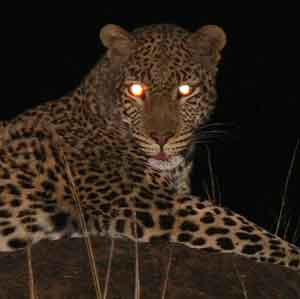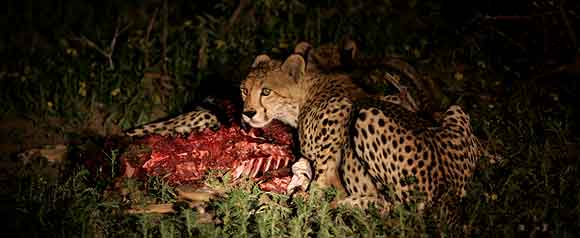Contact Details: Scotch Macaskill, Dirt Road Traders, Currys Post Road, Howick, KwaZulu-Natal, South Africa. Tel: +27 (0)82 578 2329. Privacy: Your privacy is guaranteed. See our Privacy Policy for more. This site accepts advertising and other forms of compensation - see Disclosure and Advertising for details. Site updated: 2022. Copyright © 2002 - 2022 Scotch Macaskill

| ||||||||||
|
||||||||||
|
SEE ALL
|
Safari Night Drives and the Red-Light Experienceby Roddy SmithI was always ambivalent about night drives. Actually that's not quite true - I hated night drives, which was unfortunate because I do a lot of them. Night drives are practically a trademark of the Zambian safari scene: guests love them and there is no denying that they can be exciting. If you have never done a night drive, the idea is to go out with a spotlight and locate animals by the reflection of the light from their eyes. Most mammals other than primates have a layer of reflective crystals at the back of the eye-ball called the tapetum lucidum which reflects light back onto the retina, thus making twice the amount of light available and allowing the animal to see better in the dark. For those on safari, night drives provide a great opportunity to see animals which are rarely seen in daylight: a genet flowing sinuously up a tree, a busily foraging white-tailed mongoose, a pair of porcupines rattling along the road and - with luck - the king of the night-drive, a leopard out on the hunt. The problem is that night-drives using conventional white spotlights are as intrusive and disruptive to animals going about their after-dark business as papparazzi are to royal girlfriends.
I recently had a colleague shine a spotlight at me for five seconds from 50 metres away, and I could see absolutely nothing for a considerable time afterwards. Imagine then how much greater is the effect upon creatures whose eyes are as much as six times more sensitive to light than ours. Animals such as elephants and hippos are visibly distressed by bright lights and impala become totally confused and disorientated, to the extent that back when game capture was in its infancy the standard method of catching impala was to shine a spotlight at them until you got close enough to physically tackle them, which could be rough on both parties. 
Leopard - dazzled by the light, its hunt ruined Leopards caught in the light beam are clearly revealed to their intended prey and their hunt ruined. They will often just sit down where they are, not because they are unconcerned about the vehicle but because they have been dazzled by the light and can't see anything; they can't even try to hunt again until their sight returns to normal. The longer the light has been kept on them, the longer this takes. Obviously anyone who claims to be concerned about the welfare of the wildlife must have serious reservations about this. I wish therefore to record my gratitude to the unknown genius who came up with the simple but brilliant plan of putting a red filter on the spotlight. Although this is a relatively new idea in the safari industry, navies have used it for years: ships have red lights on their bridges because red light does not affect one's night vision. When I had a colleague shine a red spotlight at me I could see perfectly as soon as it was removed, and the difference in impact on animals compared with the white light is dramatically obvious. Indeed because most mammals (other than primates) are at least partly colour-blind and cannot see the colour red, there is some doubt whether they even see the light - certainly they seem completely unconcerned and behave as though the light was not there at all.
Because the red light does not disturb the animals we are now able to get much closer and spend longer watching them and we don't have to feel guilty about it. The only slight drawback is that although the red light picks up the reflection of eyes just as well, it is slightly more difficult to make out shapes at a distance, which has prompted some guides to use a white light to locate animals and then switch to red to watch them. Sorry, but this is a cop-out; even those seconds of glare are disruptive. At Mwambashi in the Lower Zambezi we now even have red filters on our head-lights. The driver is able to see much more of what is in the darkness around him outside the light-beam, and we don't have to turn the lights off to drive past impala or elephants, leaving the driver partially blind - which can be disconcerting when there are annoyed elephants in the bush nearby. Now that we know about this there is no excuse for anyone to do a night safari drive with a white spotlight. If ever you are at a camp where they use them, you should voice your objections. It is cheap and easy to convert, and it's a lot more fun staying in a red-light establishment. Roddy Smith is a wildlife conservationist and safari guide based at Mwambashi River Lodge in the Lower Zambezi National Park, Zambia. Return to Wildlife Articles |
|||||||||
|
|
||||||||||
